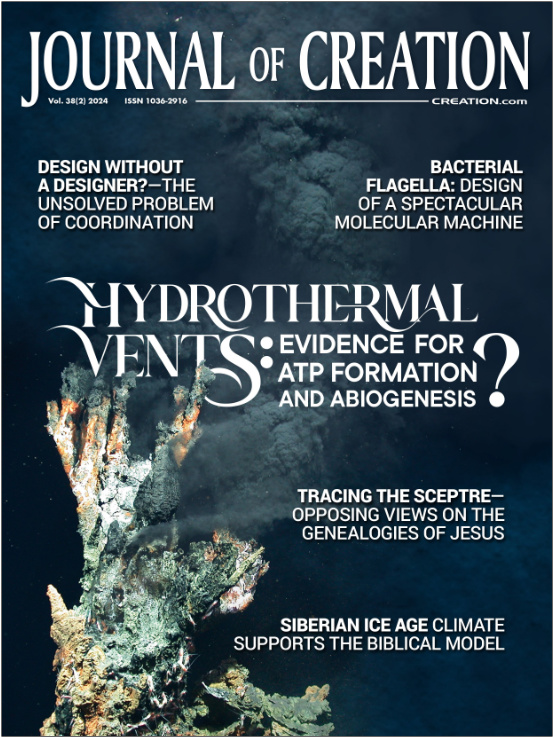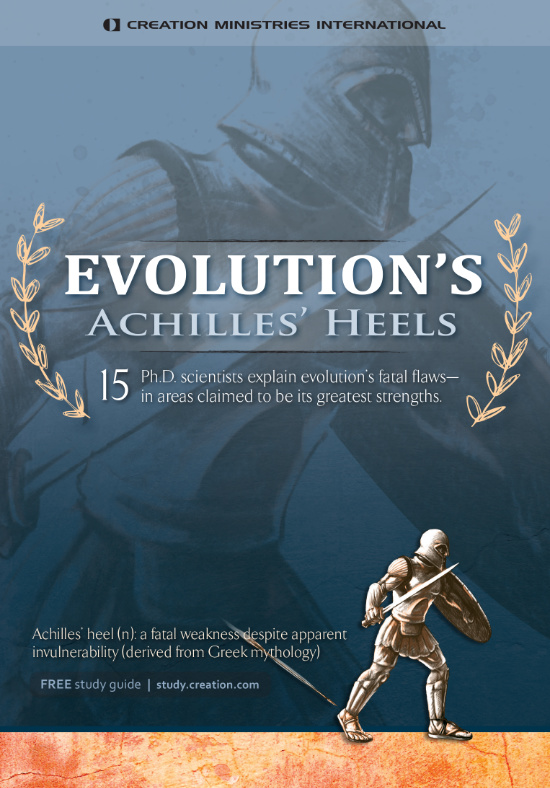Journal of Creation 38(2):13–15, August 2024
Browse our latest digital issue Subscribe
Phosphite oxidizing bacteria: support for evolutionary origin-of-life theory?
One of the key stumbling blocks to evolutionary theory is the origin of life. Many explanations have been suggested, such as life coming into existence multiple times and at different locations.1-3 Perhaps the most notable location for an origin of life has been at deep-sea thermal vents (figure 1).4 It is believed that the chemical and thermal dynamics in hydrothermal vents makes such environments highly suitable thermodynamically for chemical evolution processes to have taken place about 3.8 Myr ago in evolutionary time.5
The primary appeal of deep-sea thermal vents for the origin of life is the numerous species of extremophiles (organisms able to live in extreme conditions of temperature, pressure, salinity, pH, etc.) and other organisms currently living immediately around deep-sea vents. Also, the way in which this type of ecosystem relies on a form of chemoautotrophy (the ability to create its own energy and biological materials from inorganic chemicals) using the reduction of hydrogen sulfide as an electron donor in the absence of sunlight. It is also hoped that a study of these environments may give insights into how life may have originally arise in the hostile environments of other planets and then came to Earth (panspermia). However, this hypothesis simply pushes the evolutionary problem of the origin of life elsewhere.
A novel type of energy metabolism
Recently, two chemoautotrophic microorganisms have been identified in less extreme environments with a new type of energy metabolism believed to be an evolutionary “remnant from around 2.5 billion years ago” within the evolutionary/uniformitarian timescale.6 These bacteria use phosphite as an electron donor:
“A first dissimilatory phosphite-oxidizing bacterium, the strictly anaerobic Desulfotignum phosphitoxidans FiPS-3T was isolated from marine sediment … and oxidizes phosphite to phosphate with simultaneous reduction of sulfate to sulfide, or with homoacetogenic reduction of CO2 to acetate.”7,8
“A further strictly anaerobic dissimilarity phosphite-oxidizing bacterium “Phosphitispora fastidiosa DYL19T, was isolated recently from anaerobic sludge of a sewage treatment plant … .”7,9
Identification of both organisms is significant because it means that there are additional ways chemoautotrophic life exists besides utilizing hydrogen sulfide at deep-sea thermal vents. Overall mechanisms for phosphite oxidation involve a coupling with carbon dioxide, sulfate, or nitrate for it to be energetically favourable (see table 1).
| Table 1. Phosphite energetics (after Figueroa and Coates, ref. 10) | |
| Reactions | ∆Go (kJ/mol HPO32–) |
| 4HPO32– + SO42– + H+ → 4HPO42– + HS– | –91 |
| 4HPO32– + 2CO2 + 2H2O → 4HPO42– + CH3COO– + H+ | –77 |
| 4HPO32– + NO3– + H2O + H+ → 4HPO42– + NH3 | –89 |
| HSO3– + 3H2 → SH– + 3H2O | –172 |
| HSO3– + 3NADH + 3H+ → SH– + 3NAD+ + 3H2O | –118 |
| HSO32– + NAD+ + ADP3– → NADH + ATP4– | –14 |
Although there is only a small fraction of phosphites in today’s phosphorus minerals, they are believed to have been “more abundant in the Archean period when the Earth’s crust was less oxidized than today and played perhaps a key role in the early evolution of life.”7,10
But how novel is this biochemistry and what does it imply for life’s origin?
Phosphite oxidizing enzymes
The enzyme primarily responsible for phosphite oxidation in D. phosphitoxidans and P. fastidiosa is the AMPdependent phosphite dehydrogenase (AdpA). AdpA shows approximately 35 to 60% amino acid sequence identity within the enzyme family of the large, short-chain dehydrogenases/reductases (SDR).7
There are currently three known mechanisms for phosphite oxidation, involving coupling phosphite oxidation with either (1) carbon dioxide, (2) sulfate, or (3) nitrate for the reactions to be energetically favourable (see table 1).10 But these organisms demonstrate
“… an unusual substrate-level phosphorylation with phosphite as an inorganic electron donor. … The enzyme oxidizes phosphite with concomitant phosphorylation of AMP (adenosine monophosphate) to ADP (adenosine diphosphate), and reduction of NAD+ (oxidized nicotinamide adenine dinucleotide).”7
The clear difference of these enzymes from those in metabolic pathways discovered to date is remarkable. But the degree to which they are different also carries the burden of proof for finding some evolutionary mechanism for these to evolve from nothing. These enzymes share no significant homology to provide for an evolutionary story for their origin, which is a hallmark of intelligent design. Not only do these enzymes showcase design, but they also confuse the possibilities for evolutionary origin-of-life scenarios.
The evolutionary origin of life now more problematic
According to Darwin’s original view (figure 2), descent with modification produced a tree of life. From the 1970s through today, however, deep sequencing across many forms of life has turned the tree of life into a bush of life (figure 3).11 One major caveat to this bush of life is that life originated multiple times. Even as unscientific as it is to suggest multiple origins of life, one common assumption was that central metabolism always had carbon as the electron donor (i.e., glycolysis). The reason glycolysis is suggested as being ancient is because glycolysis is widespread across living things.12,13 It was an initial surprise, then, having to suggest hydrogen sulfide as a possible electron donor that funnels into central metabolism because very few forms of life have these pathways. So finding phosphite-based life only adds confusion to the bush of life because none of these three pathways share any homology with each other, as required from an evolutionary worldview.
(after Doolittle, ref. 11)
It is not scientific to say that carbon-based metabolism is ancient because many life forms have it, while now suggesting that phosphite-based metabolism is ancient, since only two dissimilatory phosphite oxidizers have been discovered to date. While it is possible they are suggesting both scenarios happened, the issue is that evolutionists are drawing conclusions about the early Earth without any empirical observations supporting either view—metabolic pathways do not come with birth certificates or expiration dates. The style of thinking that life originated based on either carbon, hydrogen sulfide, or phosphite metabolism instead of being part of a range in God’s created order is closed-minded and a science-stopper.
Discussion
The major findings of this study highlight a novel
“… type of phosphorylation [that] covers the major part of energy conservation in these bacteria and might represent a remnant of early biochemical evolution when phosphite was more abundant in the biosphere than it is today [emphasis added].”7
The authors continue by stating that this particular form of phosphite oxidation for energy production ‘most probably’ was preserved from a time in the early earth that no longer exists. While there is no disputing their major finding of a mechanism from two novel bacteria for phosphite oxidation and energy production, their assertion that this mechanism may have been “preserved from the primeval times of our planet” is simply a statement of faith that lacks empirical support and is a result of an evolutionary worldview, as highlighted by Denner:
“If you are to believe many of the theories of chemical evolution at all, you simply have to believe the earth’s atmosphere was once radically different from its composition today, and then look for evidence and experiments to support your belief.”14
The relatively low overall sequence similarity of these novel enzymes within the large family of SDR enzymes likely represents the unique role these microbes serve in creation. The identification of these new enzymes is, in some ways, reminiscent of the surprise discovery of microbes capable of breaking down man-made nylon.15
There are probably even more forms of life based on alternative electron donors ready to be discovered. Instead of suggesting that life randomly came into existence multiple times, we must remind ourselves of God’s wisdom. He created microorganisms, about 6,000 years ago, to handle all the different environments and chemicals found on the planet. In this sense, it represents much of what Joseph Francis has described with microbes being called ‘organosubstrate’ to make life on Earth possible.16
References and notes
- Martin W., Baross J., Kelley D., and Russell, M.J., Hydrothermal vents and the origin of life, Nature Reviews Microbiology 6(11):805–814, 2008. Return to text.
- Damer B. and Deamer D., The Hot Spring hypothesis for an origin of life, Astrobiology 20(4):429–452, 2020. Return to text.
- Wickramasinghe, N.C., Wickramasinghe, D.T., and Steele, E.J., Cometary panspermia and origin of life? Advances in Genetics 106:5–20, 2020. Return to text.
- Dodd, M., Papineau, D., Grenne, T. et al. Evidence for early life in Earth’s oldest hydrothermal vent precipitates, Nature 543:60–64, 2017. Return to text.
- Colin-Garcia, M., Heredia, A., Cordero, G., Camprubi, A., Negron-Mendoza, A., Ortega- Gutierrez, F., Beraldi, H., and Ramos-Bernal, S., Hydrothermal vents and prebiotic chemistry: a review, Boletin de la Sociedad Geológica Mexicana 68(3):599–620, 2016. Return to text.
- University Of Konstanz, Ancient power unlocked: scientists discover 2.5 billion-year-old bacterial energy source, scitechdaily.com, 20 Jan 2024. Return to text.
- Mao, Z., Fleming, J.R., Mayans, O., Frey, J., Schleheck, D., Schink, B., and Müller, N., AMP-dependent phosphite dehydrogenase, a phosphorylating enzyme in dissimilatory phosphite oxidation, PNAS 120(45):e2309743120, 2023. Return to text.
- Schink, B., Thiemann, V., Laue, H., and Friedrich, M.W., Desulfotignum phosphitoxidans sp. nov., a new marine sulfate reducer that oxidizes phosphite to phosphate, Archives in Microbiology 177:381–391, 2002. Return to text.
- Mao, Z. et al., Phosphitispora fastidiosa gen. nov. sp. nov., a new dissimilatory phosphite-oxidizing anaerobic bacterium isolated from anaerobic sewage sludge, International J. of Systematic Evolutionary Microbiology 71:1–7, 2021. Return to text.
- Figueroa, I.A. and Coates J.D., Microbial phosphite oxidation and its potential role in the global phosphorus and carbon cycles, Advances in Applied Microbiology 98:93–117, 2017. Return to text.
- Doolittle, W.F., Uprooting the tree of life, Scientific American 282(2):72–77, 2000; p. 77. Return to text.
- Ronimus R.S. and Morgan, H.W., Distribution and phylogenies of enzymes of the Embden- Meyerhof-Parnas pathway from archaea and hyperthermophilic bacteria support a gluconeogenic origin of metabolism, Archaea 1(3):199–221, 2003. Return to text.
- Doolittle, W.F., Phylogenetic classification and the universal tree, Science 284(5423):2124–2129, 1999. Return to text.
- Denner D., The primitive atmosphere, Creation 3(3):23–27, 1980. Return to text.
- Batten, D., Nylon-degrading bacteria: update, creation.com, 19 May 2017. Return to text.
- Francis, J.W., The organosubstrate of life: a creationist perspective of microbes and viruses, Proceedings of the International Conference on Creationism 5:433–444, 2003. Return to text.





Readers’ comments
Comments are automatically closed 14 days after publication.